Chapter 3: Studying the masters, 1988-90
Starting in the 1960's, Mom resumed taking art classes, at the Portland Art Museum's Art School, with such local artists as Louis Bunce and Michele Russo. From them, as from her New York teachers earlier, she learned abstraction and composition. She continued her studies in the 70's and 80's. For a while it was at Marylhust College, under art-loving nuns. Then after her husband died in 1987 she entered the docent program at the Portland Art Museum, with the idea of leading tours through the museum. She did some of that, but her real love was painting itself. She did her versions of paintings she liked, mostly from the French impressionists. Monet was her favorite. Here is Mom's version of his "Bridge at Argenteuil" (3a):
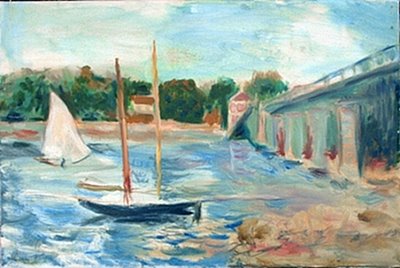
In another, the painting she is working from is Monet's "Red Boats, Argenteuil" (3b)
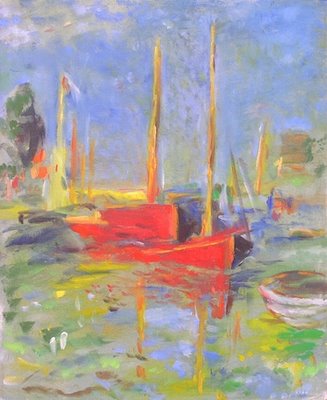
One painting of Mom'slooks like she was seeing our own waterways from a Monet-ish perspective (3c).
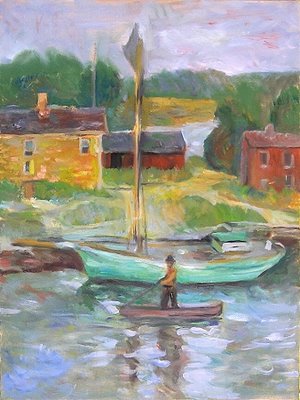
Another painting (3d) is Mom's take on a famous Mary Cassat painting, "Little Girl in a Blue Armchair." Mom would have seen the originals for 3b and 3d at the National Gallery in Washington, D.C., on one of her visits to her son John.
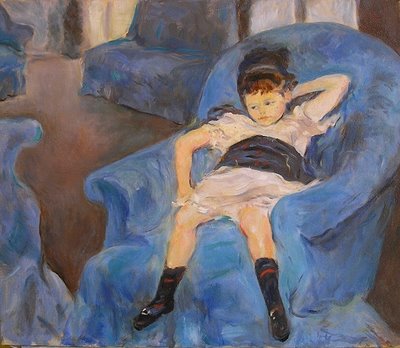
There is also her "Conversation with Bonnard" (3e), her version of his "Table Set in a Garden."
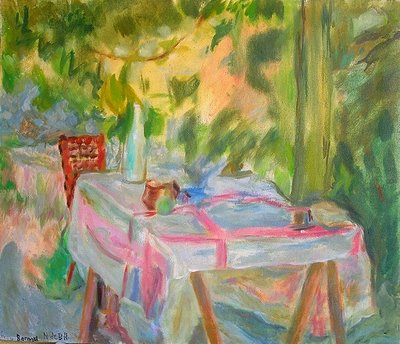
You can see images of the originals that Mom was working on Google. You click on "images," type in the name of the painting, and click on "search." If you compare the originals to Mom's versions, you will see what she is doing. She is abstracting from the impressionists, removing details yet preserving the essence of the scene and the aesthetic effect. For example, Cassat's brocaded chair becomes solid blue. It is the opposite of what is fashionable these days. Thanks to technology, cameras are getting finer and finer detail in their images, and the most sought-after artists are following the trend. Mom is aiming at less and less, while not getting away from representation altogether. Through abstraction, she is helping us to see the beauty all around us In her vacation drawings (chapter 2), she drew the expanse of a sand dune in a few well-chosen lines. Here she is doing the same even while filling the canvas with paint and color.
Two months before Mom died, I took her to the Portland Art Museum. She called out artists names to me as they appeared in the distance. She showed me one painting she said she copied, "Girl with an Accordion" by the Japanese-American artist Yasuo Kuniyoshi. Her painting, however, leaves out the accordion (3f). Mom focused on the girl. Kuniyoshi was one of her teachers at the Art Students League in 1941-1942.

After Mom died, I heard a story that might be about that painting. Around that time, the late 1980's, Mom was the Secretary of the Clackamas County Loaves and Fishes. A friend of mine who was also on the board, Ed Smith, recalls her telling him she had copied a painting in the Portland Art Museum. The artist's wife had died, and Mom told my friend that in copying the painting she experienced all the artist's grief. Of course Mom's husband had just died, too. So perhaps there was some of her own grief in that experience.
I wondered if Kuniyoshi's painting might have been the one she had in mind. Perhaps she even knew who the "girl with the accordian" was, since she studied with him. I researched Kuniyoshi on the Web. He died in 1953. His first wife, Katherine Schmidt, died in 1978. His second wife, Sara Mazo, is apparently still alive (on the Web, she shows up as guest of honor at a benefit in August, 2003.) However one commentator, writing about a 2004 Kuniyoshi retrospective in Tokyo, does observe that his later portraits of women reflect "grief and emptiness." It occurs to me that perhaps Kuniyoshi was grieving Katherine Schmidt's leaving him, a grief that perhaps never resolved. Although Schmidt divorced Kuniyoshi in 1932, she still associated with him. The Web has a photo of the two of them together in 1940. Both were artists, and both were members of "enemy" groups in the 1930's and 40's, he Japanese and she unapologetically German-American. So they continued to have much in common. There is a fascinating "oral history" interview with Schmidt on the Web that describes their relationship.. The parallel with Mom's life is then the loss of both her husbands, one to divorce and the other to death.
Around this time, too, Mom toured Europe with her friend Diana Marsden, an American who lived in England with her British husband but who visited the US often and had become close friends with Mom. The two of them bought Eurail passes and stayed in youth hostels. Mom's favorite places were Giverney, Monet's home in his later years, and Salzburg, where Diana says Mom spent eight full hours in the Mozart Museum. Salzburg is also the setting for Mom's favorite movie, "The Sound of Music." Together they got to see many of her favorite artworks, and the views that inspired them.
Mom was now ready to take up painting again in a serious way. In the 1990's and the first four years of the 21st century, her art bloomed as never before, and she left us hundreds of absolutely magical artworks. Since few of them are dated--or signed, for that matter--rather than going by date I will present them by category: still lives, nudes, dancers, musicians, portraits generally, landscapes, and finally Mom's equivalent of Giverney, the public parks where the Clackamas River flows into the Willamette, to which she kept returning again and again.

In another, the painting she is working from is Monet's "Red Boats, Argenteuil" (3b)

One painting of Mom'slooks like she was seeing our own waterways from a Monet-ish perspective (3c).

Another painting (3d) is Mom's take on a famous Mary Cassat painting, "Little Girl in a Blue Armchair." Mom would have seen the originals for 3b and 3d at the National Gallery in Washington, D.C., on one of her visits to her son John.

There is also her "Conversation with Bonnard" (3e), her version of his "Table Set in a Garden."

You can see images of the originals that Mom was working on Google. You click on "images," type in the name of the painting, and click on "search." If you compare the originals to Mom's versions, you will see what she is doing. She is abstracting from the impressionists, removing details yet preserving the essence of the scene and the aesthetic effect. For example, Cassat's brocaded chair becomes solid blue. It is the opposite of what is fashionable these days. Thanks to technology, cameras are getting finer and finer detail in their images, and the most sought-after artists are following the trend. Mom is aiming at less and less, while not getting away from representation altogether. Through abstraction, she is helping us to see the beauty all around us In her vacation drawings (chapter 2), she drew the expanse of a sand dune in a few well-chosen lines. Here she is doing the same even while filling the canvas with paint and color.
Two months before Mom died, I took her to the Portland Art Museum. She called out artists names to me as they appeared in the distance. She showed me one painting she said she copied, "Girl with an Accordion" by the Japanese-American artist Yasuo Kuniyoshi. Her painting, however, leaves out the accordion (3f). Mom focused on the girl. Kuniyoshi was one of her teachers at the Art Students League in 1941-1942.

After Mom died, I heard a story that might be about that painting. Around that time, the late 1980's, Mom was the Secretary of the Clackamas County Loaves and Fishes. A friend of mine who was also on the board, Ed Smith, recalls her telling him she had copied a painting in the Portland Art Museum. The artist's wife had died, and Mom told my friend that in copying the painting she experienced all the artist's grief. Of course Mom's husband had just died, too. So perhaps there was some of her own grief in that experience.
I wondered if Kuniyoshi's painting might have been the one she had in mind. Perhaps she even knew who the "girl with the accordian" was, since she studied with him. I researched Kuniyoshi on the Web. He died in 1953. His first wife, Katherine Schmidt, died in 1978. His second wife, Sara Mazo, is apparently still alive (on the Web, she shows up as guest of honor at a benefit in August, 2003.) However one commentator, writing about a 2004 Kuniyoshi retrospective in Tokyo, does observe that his later portraits of women reflect "grief and emptiness." It occurs to me that perhaps Kuniyoshi was grieving Katherine Schmidt's leaving him, a grief that perhaps never resolved. Although Schmidt divorced Kuniyoshi in 1932, she still associated with him. The Web has a photo of the two of them together in 1940. Both were artists, and both were members of "enemy" groups in the 1930's and 40's, he Japanese and she unapologetically German-American. So they continued to have much in common. There is a fascinating "oral history" interview with Schmidt on the Web that describes their relationship.. The parallel with Mom's life is then the loss of both her husbands, one to divorce and the other to death.
Around this time, too, Mom toured Europe with her friend Diana Marsden, an American who lived in England with her British husband but who visited the US often and had become close friends with Mom. The two of them bought Eurail passes and stayed in youth hostels. Mom's favorite places were Giverney, Monet's home in his later years, and Salzburg, where Diana says Mom spent eight full hours in the Mozart Museum. Salzburg is also the setting for Mom's favorite movie, "The Sound of Music." Together they got to see many of her favorite artworks, and the views that inspired them.
Mom was now ready to take up painting again in a serious way. In the 1990's and the first four years of the 21st century, her art bloomed as never before, and she left us hundreds of absolutely magical artworks. Since few of them are dated--or signed, for that matter--rather than going by date I will present them by category: still lives, nudes, dancers, musicians, portraits generally, landscapes, and finally Mom's equivalent of Giverney, the public parks where the Clackamas River flows into the Willamette, to which she kept returning again and again.

0 Comments:
Post a Comment
<< Home